The internet is no longer just a collection of flat web pages. A new dimension is emerging – the Metaverse, where traditional SEO rules no longer apply as they once did. Companies that master brand promotion in the Metaverse early on will gain a competitive edge for years to come.
In this guide, we’ll break down practical steps to help you adapt your website for Web3, identify the right metaverse keywords, and build your brand’s virtual authority. We’ll ensure you’re ready to navigate this new digital era without getting lost.
Introduction to the New Digital Era: Why the Metaverse Changes SEO Rules
According to MarketsandMarkets, the metaverse market is projected to reach $1,303.4 billion by 2030. It’s time to understand how to ride this wave.
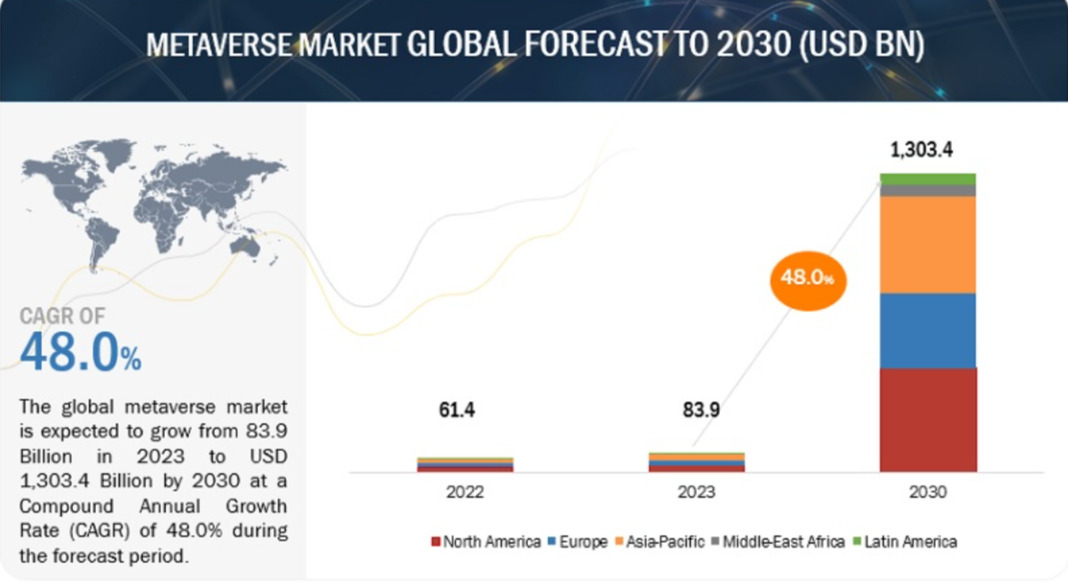
What Is the Metaverse? Moving Beyond 2D Screens (VR, AR, Web3, Digital Assets)
The metaverse isn’t just a game or an app – it’s an ecosystem of interconnected virtual worlds where physical and digital realities converge.
Imagine not just staring at a screen but fully immersing yourself in a digital environment. You put on VR glasses and find yourself at your favorite band’s concert alongside friends who are physically on the other side of the globe. Or you use AR glasses to try on virtual clothing while standing in front of a mirror in your apartment.
Key metaverse technologies include:
- Virtual Reality (VR) – complete immersion in a digital world.
- Augmented Reality (AR) – overlaying digital objects onto the real world.
- Web3 – a decentralized internet powered by blockchain.
- Digital Assets – NFTs, cryptocurrencies, and virtual real estate. More on these later.
Gartner’s research predicts that by 2026, about 25% of people will spend at least one hour a day in the metaverse. This isn’t just a trend – it’s a new reality where Metaverse SEO is becoming a critical skill for marketers.
The Evolution of Search: From Text Queries to Voice, Visuals, and Intent Analysis
Search engines in the metaverse differ drastically from traditional ones like Google. In virtual worlds, users don’t type – they speak, gesture, and interact with their surroundings.
Here’s how search is evolving:
- Voice Search – the primary method in VR, where typing is inconvenient.
- Visual Search – searching via images of objects or gestures.
- Contextual Search – factoring in your location within the virtual space.
- Intent-Oriented Search – analyzing user goals rather than just queries.
In the metaverse, a user might point at an object and ask, “What is this?” or “Where can I buy one like it?” The system analyzes the virtual object and delivers results.
This demands a radically new approach to search engine optimization for virtual worlds. Instead of focusing on keywords, optimization now starts with visual design, 3D modeling, and interactivity.
Why Your Business Needs SEO for the Metaverse Today
You might be thinking, “This sounds interesting, but why do I need it now?” Here are a few reasons, all tied to competitive advantage:
- Early-Mover Advantage. Those who establish a presence in virtual spaces now will enjoy the same first-mover benefits as early SEO adopters in the 2000s.
- New Audience. Gen Z and Gen Alpha practically live in digital spaces. According to CryptoSlate, these generations will drive metaverse growth, making them your future audience.
- Lower Competition. The metaverse currently has far less competition than traditional online spaces, allowing you to secure prime positions with fewer resources.
- Innovative Brand Image. Brands embracing the metaverse are seen as forward-thinking and future-oriented.
Metaverse marketing isn’t just a trendy buzzword – it’s an investment in your business’s future. Even if you’re not ready to fully dive into virtual worlds, understanding the basics of VR and AR SEO will give you an edge over competitors.
Building a Foundation for Virtual Success: Technical SEO for the Metaverse
Without a solid technical foundation, any strategy will crumble. In virtual worlds, the demands on websites and platforms are even stricter.

Metaverse Glossary: Understanding Key Terms (NFTs, Digital Twins, Blockchain, Crypto Wallets)
To excel in Web3 SEO, you first need to master the metaverse’s unique language. Here are the key terms every SEO professional should know:
- NFT (Non-Fungible Token) – a unique digital asset verifying ownership of a virtual or physical item, used in the metaverse for virtual land, avatars, or items.
- Digital Twin – a virtual replica of a physical object or person, often used as a brand’s representation in the metaverse.
- Blockchain – a decentralized system for secure, transparent data recording in the metaverse.
- Crypto Wallet – a digital tool for storing cryptocurrencies and NFTs, also used for authentication in metaverse spaces.
- Virtual Land – digital real estate in the metaverse that can be bought, sold, or developed.
- Avatar – your digital representation in the metaverse, ranging from a 2D image to a full 3D model.
- Decentralized Apps (dApps) – blockchain-based applications without a central server.
- Smart Contracts – self-executing blockchain programs that automate agreements.
Understanding these terms is the first step toward effective SEO strategies for the Metaverse. They form the backbone of your virtual promotion strategies.
Optimizing Speed and Performance: Lag-Free Loading in Immersive Environments
In traditional SEO, page load speed is a critical ranking factor. In the metaverse, it’s even more vital. Lags and delays don’t just annoy users – they can cause physical discomfort in VR.
Key performance optimization techniques:
- 3D Model Optimization. Use Level of Detail (LOD) techniques, reducing polygon counts for objects farther away.
- Progressive Loading. Load the user’s immediate surroundings first, then distant elements as they move.
- Resource Caching. Store frequently used textures and models locally on the user’s device.
- Texture Optimization. Use VR/AR-compatible compression formats like Basis Universal.
- Minimize Draw Calls. Combine similar objects to reduce GPU load.
Tools for optimization:
- Unity Profiler for analyzing VR app performance.
- Blender for optimizing 3D models.
- Oculus Debug Tool for testing VR performance.
Website optimization for the Metaverse goes beyond technical tweaks – it must consider user physiology. For instance, maintaining a stable frame rate (90–120 FPS for VR) is crucial to prevent motion sickness.
Security and Privacy: HTTPS, Crypto Wallet Authentication, and User Trust
Security is paramount in a decentralized environment. Users don’t just share data – they conduct transactions with real value and grant access to virtual assets. A data breach or wallet hack can ruin your reputation.
Core security principles in the metaverse:
- HTTPS and Web3 protocols as the baseline for secure communications.
- Crypto wallet authentication as a modern alternative to passwords.
- Multi-factor authentication for added protection.
- Audited smart contracts to ensure secure transactions.
- Transparent data policies to clarify how user information is used.
Crypto wallets are becoming the standard for identity verification in the metaverse. Instead of creating accounts, users connect their wallets to your platform.

For SEO professionals, this means integrating these technologies into your site’s structure and ensuring proper indexing. Search engines prioritize secure platforms, and in the metaverse, these requirements will only intensify.
Virtual reality SEO must address both technical security and user psychology. People need to feel confident interacting with your brand in virtual spaces.
Structured Data (Schema.org) for Virtual Objects and Events
How will a search engine know your virtual object is a store, not just a 3D model? Structured data is the answer, and its role in the metaverse is growing.
Adapting Schema.org for the metaverse:
- Virtual Events – Use extended Event markup with VR/AR access parameters.
- 3D Objects and NFTs – Expand Product schemas with new attributes.
- Virtual Locations – Describe metaverse spaces with specific metadata.
Metaverse SEO trends involve not only marking up virtual objects but also linking them together. While some fields aren’t yet standard in Schema.org, early adoption will prepare you for future updates.
Creating a Sitemap for Virtual Spaces: Indexing 3D Objects and Worlds

A sitemap is a core SEO element, helping search engines index your resources. But how do you create one for a 3D space?
Key approaches to virtual navigation:
- Coordinate System – Assign unique coordinates to objects and locations (e.g., Decentraland’s (x,y) system).
- Hierarchical Structure – Divide worlds into regions, districts, buildings, etc. (e.g., World > Continent > City > District > Building > Floor > Room > Object).
- Portals and Teleports – Connect disparate spaces, represented as special links in XML sitemaps.
Include metadata for each object:
- Object type (static or interactive).
- 3D model format (glb, fbx, obj).
- Connections to other objects.
- Available actions for the object.
Search optimization for augmented reality highlights that search engines will increasingly focus on navigating 3D spaces. A clear, logical structure for your virtual space will be as critical as a traditional website’s structure.
Content Marketing and Keywords in Immersive Environments
Content remains king, but its formats and distribution methods are transforming.
New Content Formats: From Articles to 3D Models, Interactive Tours, and VR Experiences
In the metaverse, traditional text content takes a backseat to immersive formats. Text won’t disappear, but it’s now just one part of a layered experience.
New metaverse content formats:
- 3D Models and Scenes – Interactive three-dimensional objects with optimized file names, metadata, and text descriptions.
- Interactive Tours – Guided journeys through virtual spaces with informational hotspots, like a virtual showroom showcasing products.
- Immersive Presentations – Talks and demos in virtual spaces that engage audiences.
- Gamified Experiences – Educational or marketing content as mini-games or quests.
- Social Spaces – Areas for user interaction where brands facilitate communication.
SEO professionals need new skills:
- Basic 3D modeling knowledge.
- VR/AR UX/UI principles.
- Fundamentals of game design and interactive storytelling.
- Proficiency with VR/AR content creation tools.
Content marketing in VR demands rethinking traditional metrics. Key indicators include:
- Time spent interacting with objects.
- Depth of immersion (via VR eye-tracking).
- Emotional response (measurable through biometrics).
- Social sharing (inviting friends to virtual spaces).
Keyword Research for the Metaverse: Analyzing Voice and Contextual Queries
Keyword research remains the bedrock of SEO, but in the metaverse, it takes on new dimensions due to how users interact with virtual worlds.
Metaverse search characteristics:
- Voice Search Dominance – Typing is impractical in VR, leading to:
- Longer, conversational queries.
- Question-based phrases (“where can I find…” instead of “buy…”).
- Less precise wording.
- Gesture-Based Search – Users point at objects and ask questions, requiring visual and textual optimization.
- Contextual Search – Queries depend on the avatar’s location and prior actions.
Metaverse keywords often include:
- Virtual world terminology (“where to buy NFTs,” “virtual land”).
- Spatial indicators (“nearby,” “inside,” “above”).
- Virtual actions (“how to teleport,” “how to interact”).
Example keyword table for a fashion brand in the metaverse:
| Traditional Query | Metaverse Query |
|---|---|
| Buy sneakers | Where to find virtual sneakers |
| Fashion clothing | What does NFT clothing look like |
| Fitting room | How to try on a new collection for my avatar |
Semantic Core and LSI Phrases for Virtual Goods and Services
Building a semantic core for metaverse marketing requires understanding new query categories tied to virtual products and services.
Semantic core structure for the metaverse:
- Core Queries – General metaverse terms:
- Metaverse
- Virtual reality
- VR experience
- NFT assets
- Product Queries – Virtual goods specifics:
- Virtual clothing for avatars
- Digital real estate in Decentraland
- Collectible NFT items
- Virtual furniture for the metaverse
- Service Queries – Virtual space services:
- Virtual space design
- 3D avatar creation
- Metaverse event planning
- Virtual consultations
- Navigational Queries – Virtual space search:
- How to find a store in Decentraland
- The Sandbox map
- Teleport to Fashion Street
- Nearest virtual showroom
LSI phrases for the metaverse should reflect its interdisciplinary nature:
- Technical terms: blockchain, cryptocurrency, token, smart contract.
- Gaming terms: avatar, skin, loot, inventory.
- Design terms: 3D model, texture, rendering, polygons.
- Financial terms: virtual land investments, NFT pricing.
Search engine optimization for virtual worlds demands ongoing monitoring of new terms and concepts as the field evolves rapidly.
Content Marketing in VR: Creating Engaging, Immersive Experiences
Content marketing in VR requires rethinking how information is created and shared. The key principle: don’t just tell – let users feel and experience.
Core principles for effective VR content:
- Interactivity – Users should actively engage with content, not passively consume it. Instead of a product description, offer an interactive 3D model to explore.
- Emotional Engagement – VR activates the brain’s limbic system more than 2D media, creating memorable experiences.
- Layered Information – Provide basic info upfront, with deeper details revealed through interaction.
- Social Interaction – Enable users to share experiences, boosting engagement.
Examples of VR content marketing formats:
- Virtual showrooms with interactive exhibits.
- Immersive brand stories and narratives.
- Product usage simulations.
- Social hubs for user interaction.
- Temporary metaverse events and performances.
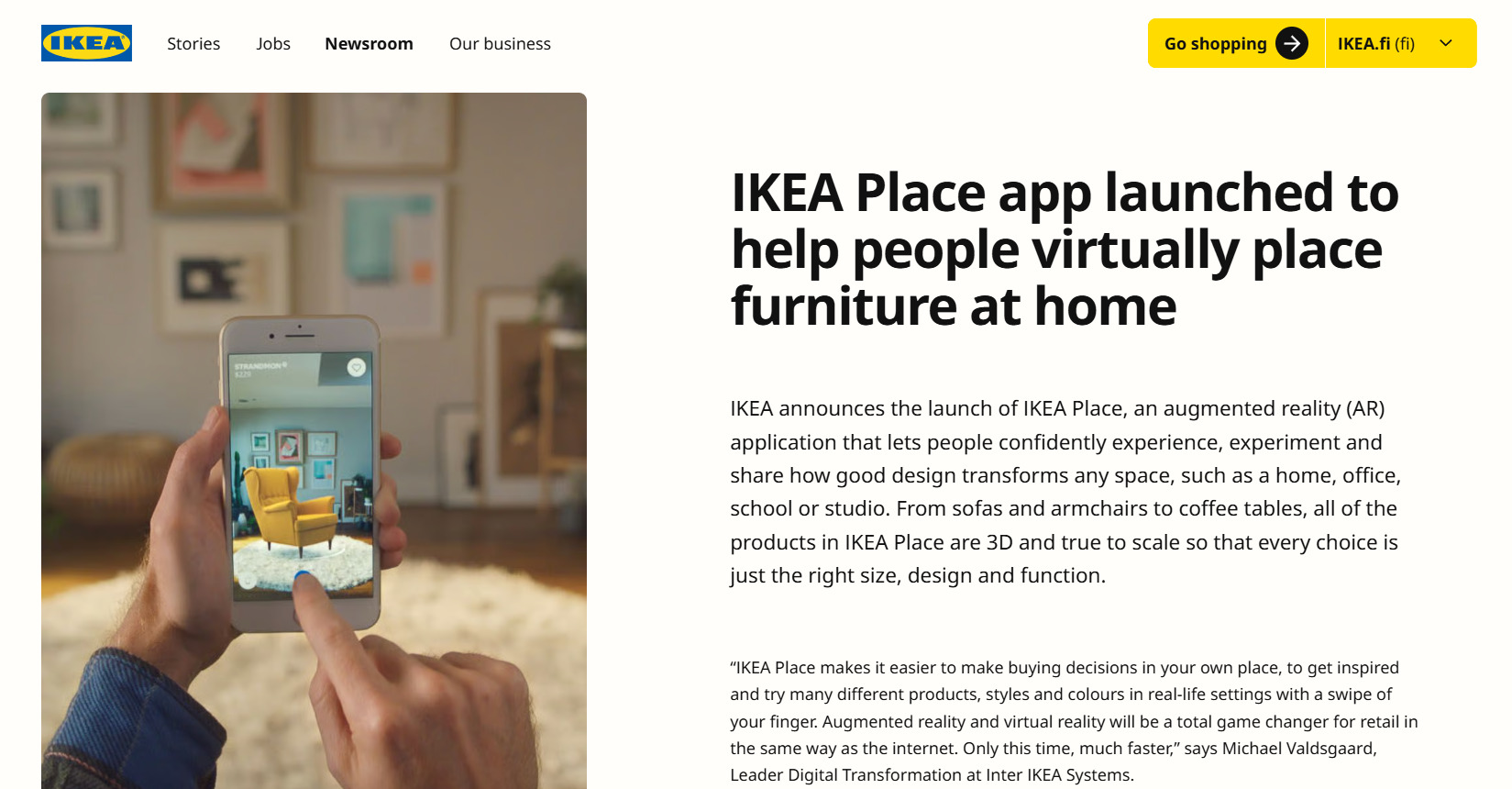
Digital marketing in the Metaverse demands close attention to UX design. Poor interfaces or complex navigation can ruin even the best content. Key considerations:
- Intuitive controls.
- Preventing VR motion sickness.
- Balancing detail and performance.
- Ergonomic VR movement design.
One effective approach is creating “information layers,” letting users choose their depth of engagement. For example, a virtual car showroom could offer:
- Exterior vehicle inspection.
- Interactive cabin exploration.
- Engine visualization.
- Test-drive simulation.
Optimizing Meta Tags and Titles for Virtual Search Engines
Even in the 3D metaverse, textual metadata remains critical for search. However, titles and descriptions must reflect immersive experiences, not just list keywords.
In the metaverse, users search for experiences – trying, visiting, or testing something. Your meta tags should anticipate this.
For example, instead of “Buy Nike sneakers,” use “Try on the latest Nike sneakers in our virtual showroom.” This immediately conveys the value of the experience.
Website optimization for the Metaverse also involves adapting traditional web pages linked to your virtual presence. These pages should include:
- Instructions for accessing your virtual space.
- Previews of the virtual experience.
- Hardware requirements.
- A metaverse event calendar.
Virtual search engines increasingly rely on contextual and visual signals, but textual metadata remains the foundation for indexing and categorization.
Building Virtual Presence and Brand Authority
Promoting in the metaverse requires new strategies. You need to create a visible virtual presence for both users and algorithms. Here’s how.
Creating and Optimizing a Brand’s Virtual Presence (Showroom, Office, Land)
Your virtual presence is your “home” in the metaverse – a key touchpoint with your audience. Its creation demands a strategic approach and an understanding of virtual architecture.
Types of virtual spaces:
- Virtual Showroom – A space for product demos:
- Interactive 3D product models.
- Try-on or testing features.
- Instant purchases (physical or digital).
- Digital Office – A hub for client communication:
- Consultation and meeting zones.
- Virtual staff (avatars or AI).
- Informational displays and presentations.
- Virtual Land – Digital real estate investment:
- Strategic placement in high-traffic areas.
- Scalability potential.
- Leasing opportunities for other brands.
Optimizing virtual spaces for search:
- Geolocation Optimization – Place your space in high-traffic metaverse districts.
- Visual Landmarks – Eye-catching design elements that stand out from afar, like branded skyscrapers in the real world.
- Navigation Structure – Intuitive movement systems with clear signposts.
- Interactive Points of Interest – Elements encouraging exploration and engagement.
- Space Metadata – Hidden tags and descriptions for metaverse search engines.
A notable example is Nike’s virtual space in Roblox, called Nikeland.

Metaverse Marketing Through Augmented Reality (AR): Bridging Digital and Physical Worlds
Augmented reality (AR) is a powerful tool that connects physical and virtual realms. Unlike VR, AR doesn’t require full immersion and is accessible on most modern smartphones.
AR marketing strategies:
- AR Try-Ons – Virtual fitting for clothing, shoes, accessories, or makeup:
- IKEA Place for visualizing furniture in real spaces.
- Zara’s virtual fitting rooms.
- L’Oreal ModiFace for cosmetics testing.
- AR Packaging – Interactive labels and packaging:
- QR codes triggering AR content.
- Animated characters emerging from packaging.
- AR-layered storytelling.
- Geolocation AR Experiences – Location-based content:
- AR store guides.
- Virtual characters in real-world locations.
- Gamified urban quests.
- AR Portals to the Metaverse – Gateways from the physical to virtual world:
- AR markers unlocking virtual spaces.
- Physical objects as keys to digital assets.
- QR codes for teleporting avatars to specific metaverse locations.
Optimizing AR content for search:
- Geotags and Location Tying – Help search engines understand where your AR experience is available.
- AR-Specific Metadata – Details on AR content type, device requirements, and asset size.
- Cross-Links – Connect physical and virtual versions of your brand.
Search optimization for augmented reality bridges traditional SEO and metaverse SEO trends, enabling:
- Engagement with audiences not yet ready for full VR immersion.
- Omnichannel marketing campaigns.
- Data collection on user interactions with physical objects.
- Testing metaverse concepts with lower costs.
According to Fortune Business Insights, the virtual fitting room market will reach $24.3 billion by 2032, underscoring AR’s massive retail potential.
Partnerships with Brands and Creators in the Metaverse

Collaborations and partnerships in the metaverse amplify opportunities for cross-branding and joint projects that would be complex or impossible in the physical world.
Types of strategic partnerships:
- Brand + Brand – Company collaborations:
- Shared virtual spaces.
- Limited-edition digital goods.
- Joint events and activations.
- Brand + Crypto Project – Blockchain integrations:
- Accepting specific cryptocurrencies.
- Exclusive content for NFT holders.
- Co-branded token drops.
- Brand + Content Creator – Working with metaverse influencers:
- Virtual brand ambassadors.
- Content creation in branded spaces.
- Advocates in virtual worlds.
- Brand + Metaverse Platform – Integration with virtual worlds:
- Official partnerships with Decentraland, The Sandbox, or Roblox.
- Exclusive features and privileges.
- Co-marketing initiatives.
SEO benefits of partnerships:
- Expanded Digital Footprint – Brand mentions in new contexts.
- Access to New Audiences – Tapping into partner communities.
- Increased Authority – Association with established metaverse players.
- Organic Link Building – Generating natural mentions and links.
Metaverse marketing through partnerships is particularly effective for brands entering the metaverse, often yielding greater media exposure than standalone efforts.
Managing Reputation in Virtual Worlds: Reviews, Mentions, and Social Signals
Reputation in the metaverse forms and spreads differently than in traditional online spaces. The decentralized nature of virtual worlds creates new challenges and opportunities.
Key reputation components:
- User Reviews and Reactions – These may include:
- Recorded VR experiences.
- Visual reactions or tags on objects.
- Blockchain-verified ratings.
- Metaverse Social Signals:
- Visitor counts to your virtual space.
- Time spent interacting with your brand.
- Virtual selfies with branded objects.
- Viral spread of virtual goods.
- Mentions in Virtual Communities:
- Discussions in Discord channels.
- Mentions within virtual worlds.
- Metaverse forum conversations.
- References on NFT marketplaces.
Reputation management strategies:
- Monitoring Mentions – Use specialized tools to track brand conversations in the metaverse.
- Proactive Review Management:
- Create feedback zones in virtual spaces.
- Reward constructive reviews with tokens or NFTs.
- Implement gamified reputation systems.
- Engaging Virtual Ambassadors:
- Loyalty programs for active users.
- Incentives for user-generated content.
- Crisis Management:
- Protocols for addressing negativity.
- Transparent communication across channels.
- Smart contracts for automatic issue resolution.
SEO for the Metaverse is closely tied to reputation management, as search algorithms increasingly factor in user experience and social signals. Positive reviews and active engagement boost your virtual visibility.
Proving Experience, Expertise, Authority, and Trust (E-E-A-T) in Decentralized Spaces
Google’s E-E-A-T principles (Experience, Expertise, Authoritativeness, Trustworthiness) remain vital in the metaverse, but their implementation requires new approaches. Traditional authority signals (domain age, backlinks) give way to new indicators.
Demonstrating expertise in the Metaverse:
- Blockchain Verification – Prove authenticity via:
- Verified NFTs with company details.
- Smart contracts with transparent transaction histories.
- Cryptographic signatures tied to objects.
- Metaverse History – Evidence of sustained presence:
- Dated virtual assets.
- Archives of past events.
- Virtual “museums” showcasing your brand’s evolution.
- Social Proof – Community recognition:
- Blockchain-based review systems.
- Public visit and interaction stats.
- Partnerships with reputable metaverse players.
- Educational Content – Showcasing knowledge:
- Virtual workshops and seminars.
- Interactive learning spaces.
- Published metaverse research.
Technical E-E-A-T aspects:
- Digital Identity – Verified presence via:
- Ethereum Name Service (ENS) domains.
- Public blockchain profiles.
- Cross-links between Web2 and Web3 assets.
- Data Transparency – Clarity on:
- Virtual goods’ origins.
- Data usage policies.
- Monetization mechanisms.
- Technological Safeguards:
- Independent smart contract audits.
- User protection mechanisms.
- Dispute resolution systems.
SEO strategies for the Metaverse must systematically build E-E-A-T signals tailored to decentralized environments. This long-term investment:
- Improves visibility in metaverse search engines.
- Boosts user trust in your virtual presence.
- Lays a foundation for sustained metaverse success.
As metaverse search algorithms evolve, E-E-A-T will become even more critical due to heightened security and financial risks in virtual spaces.
External Optimization (Link Building) and Community Engagement in Web3
In Web3, the rules of link building shift. Traditional backlinks give way to new citation formats. Your goal is to create a robust system of brand mentions in decentralized spaces.
New Types of “Backlinks”: Whitepaper Mentions, DAO Partnerships, and NFT Marketplace Listings
In the metaverse, backlinks take new forms. Mentions in project whitepapers are the digital equivalent of editorial links, signaling trust and relevance.
Decentralized Autonomous Organizations (DAOs) offer unique partnership opportunities. Collaborative initiatives generate organic mentions in blockchain ecosystems.
Listings on NFT marketplaces like OpenSea or Rarible act as citations, boosting visibility and credibility.
Strategies include:
- Analyzing projects for whitepaper mention opportunities.
- Engaging in DAOs through proposals and voting.
- Listing NFT collections on multiple marketplaces.
- Monitoring mentions in smart contracts.
- Forming mutually beneficial Web3 partnerships.
These methods build a reputation profile in an environment where traditional links are losing relevance.
Creating Viral Content for Virtual Worlds
Viral content in the metaverse requires interactivity, social value, and unique experiences:
- Interactive Events – Host quests with rewards that encourage friend participation, driving organic sharing.
- Limited-Edition Digital Assets – Release NFT collections with unique traits users want to showcase.
- Gamification Elements – Introduce achievement systems displayed in user profiles.
Key viral content elements:
- Socially driven interactive mechanics.
- Exclusive event and collection access.
- Visually striking AR effects.
- Incentives for inviting friends.
- Integration with social platforms.
Such content spreads organically, expanding reach without heavy ad spend.
Encouraging User-Generated Content (UGC) Around Your Brand
UGC in the metaverse is a cornerstone of social proof, often outperforming traditional ads. To stimulate it:
- Enable Creative Infrastructure – Provide tools like avatar templates, 3D object libraries, or virtual photo filters.
- Reward Quality Content – Offer NFTs for top contributions, granting access to exclusive events or products.
- Host Regular Contests – Define themes, formats, and voting systems, then share results on your project’s social channels.
Other effective methods:
- Loyalty programs with NFT rewards.
- Social sharing features.
- Showcasing top UGC in official spaces.
- Personalized creator acknowledgments.
This creates a steady stream of content and strengthens community ties.
Participating in Virtual Events, Conferences, and Exhibitions for Brand Visibility
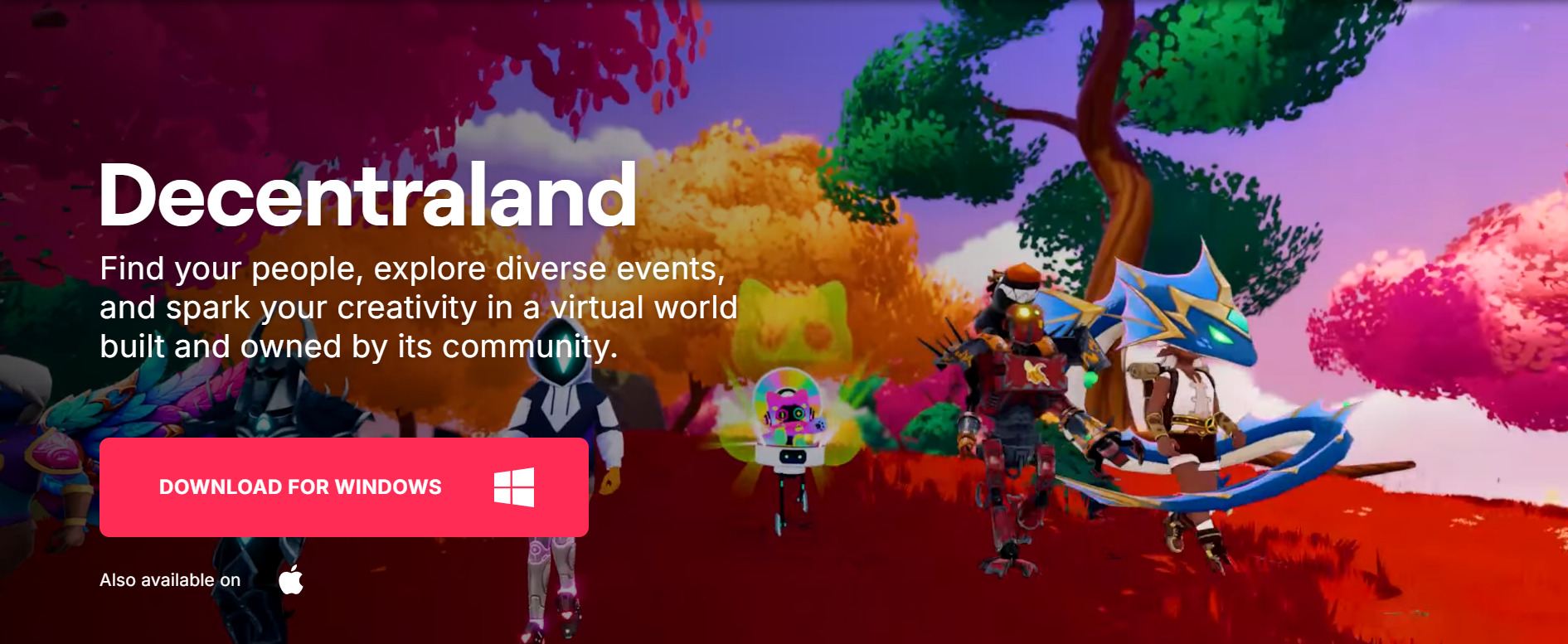
Virtual events are now key platforms for networking and promotion. Strategic participation boosts brand positioning:
- Choose Targeted Events – Analyze audience and themes to focus on relevant opportunities.
- Engage Actively – Speak, host side events, or offer exclusive content rather than just attending.
- Leverage Cross-Platform Promotion – Announce participation via social media, blogs, and newsletters, creating event-specific materials.
Post-event, maintain connections with attendees through follow-up materials or mailing lists, turning one-off interactions into lasting relationships.
Measuring Success: Analytics and ROI Tracking in the Metaverse
Evaluating performance in virtual spaces requires new approaches. Traditional web analytics don’t always capture the full picture.
Defining Goals and KPIs for Your Metaverse SEO Strategy
Start with business objectives, not just virtual metrics. Align metaverse activities with your company’s broader goals.
Set SMART KPIs, such as:
- Specific: Increase user time spent by 25%.
- Measurable: Boost transactions by 15%.
- Achievable: Based on available resources.
- Relevant: Tied to business goals.
- Time-Bound: Set for a quarter or year.
Example KPIs by stage:
- Awareness: Reach, mentions, traffic.
- Engagement: Time spent, activity, UGC.
- Conversion: Wallet connections, transactions.
- Loyalty: Return visits, referrals.
Regularly reassess metrics, as the industry evolves quickly. Link virtual KPIs to real-world business outcomes to demonstrate impact.
Key Metrics for Virtual Success: Beyond Traffic to Engagement, Time Spent, and NFT Sales
Focus on interaction quality over visit quantity. Time spent in your virtual space reflects genuine interest.
Measure engagement through actions like:
- Interactions with objects.
- AR effect activations.
- Event participation.
- Content saving or sharing.
NFT sales are a core financial metric. Track transaction volume and average sale value, as well as secondary market activity for long-term asset value.
Social metrics include:
- Brand mentions in virtual chats.
- UGC volume.
- Community participation.
- Social shares and recommendations.
Together, these provide a comprehensive view of performance.
Analytics Tools for Virtual Worlds (Current and Emerging)
Standard analytics tools often fall short in Web3. Use specialized blockchain analytics solutions:
- Dune Analytics – Custom dashboards for tracking blockchain activity.
- Nansen – Analyzes wallet behavior and transaction trends.
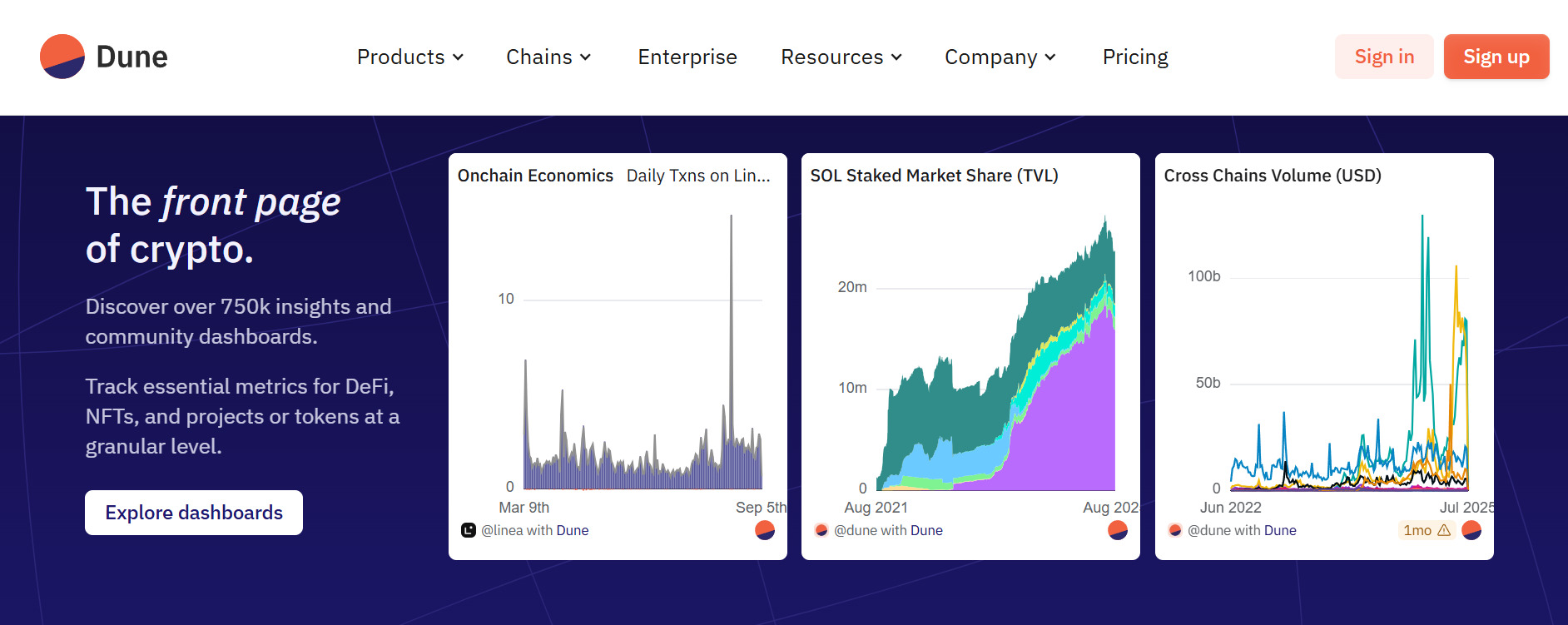
Built-in platform analytics:
- Decentraland Analytics – Tracks land visitation.
- Cryptovoxels – Monitors activity.
- Spatial.io – Provides engagement data.
Emerging AI tools for analyzing avatar behavior and predicting trends are on the horizon, promising rapid advancements in metaverse analytics.
Tracking Conversions in a Decentralized Environment
Wallet connection is a key conversion, signaling user readiness to engage. Track successful connection rates against total attempts.
Set up events for key actions:
- Transaction signings.
- Voting participation.
- Virtual asset purchases.
- NFT collection interactions.
Use UTM tags for traffic source tracking, even in decentralized apps, to gauge channel effectiveness.
Multi-chain analytics are essential, as users operate across Ethereum, Polygon, Solana, and more. Collect data from all relevant blockchains.
Post-conversion behavior informs LTV:
- Activity post-wallet connection.
- Return visit frequency.
- Long-term engagement.
- Cross-platform transitions.
Trends and Future of Search Engine Optimization for Virtual Worlds
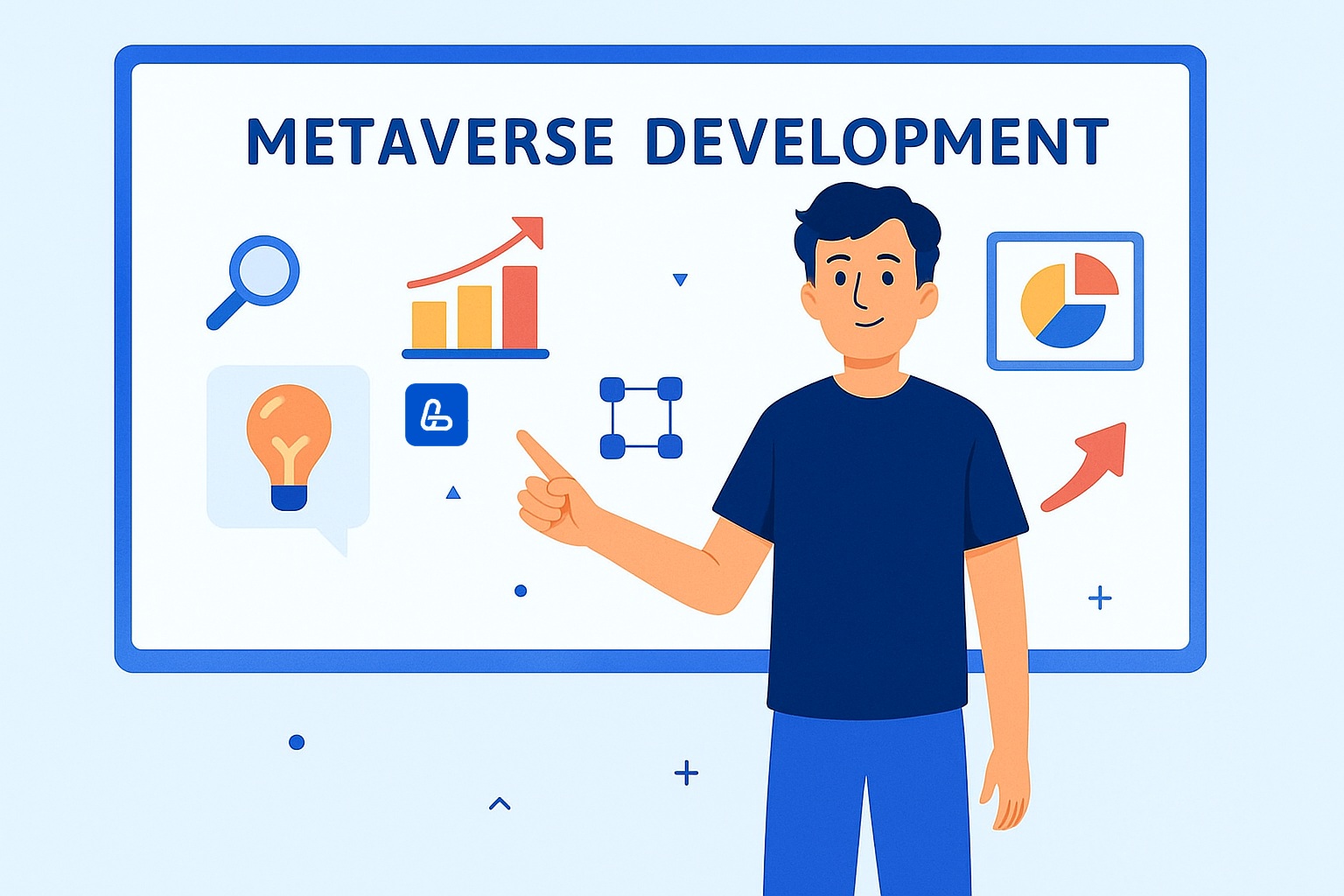
Virtual space technologies are evolving rapidly. Virtual reality SEO requires staying ahead of trends and adapting to change. New approaches are already shaping the future of digital marketing in the Metaverse.
Artificial Intelligence and Personalized Search in the Metaverse
AI is transforming search optimization. In the metaverse, AI analyzes not just text queries but user behavior, visit history, preferences, and social connections. Search suggestions are tailored based on a user’s digital environment.
AI-driven Metaverse SEO is becoming essential. Traditional methods are giving way to optimization for machine learning algorithms, requiring content that AI recognizes as relevant and valuable.
AI SEO services from LinkBuilder.com offer solutions for adapting content to intelligent search systems.
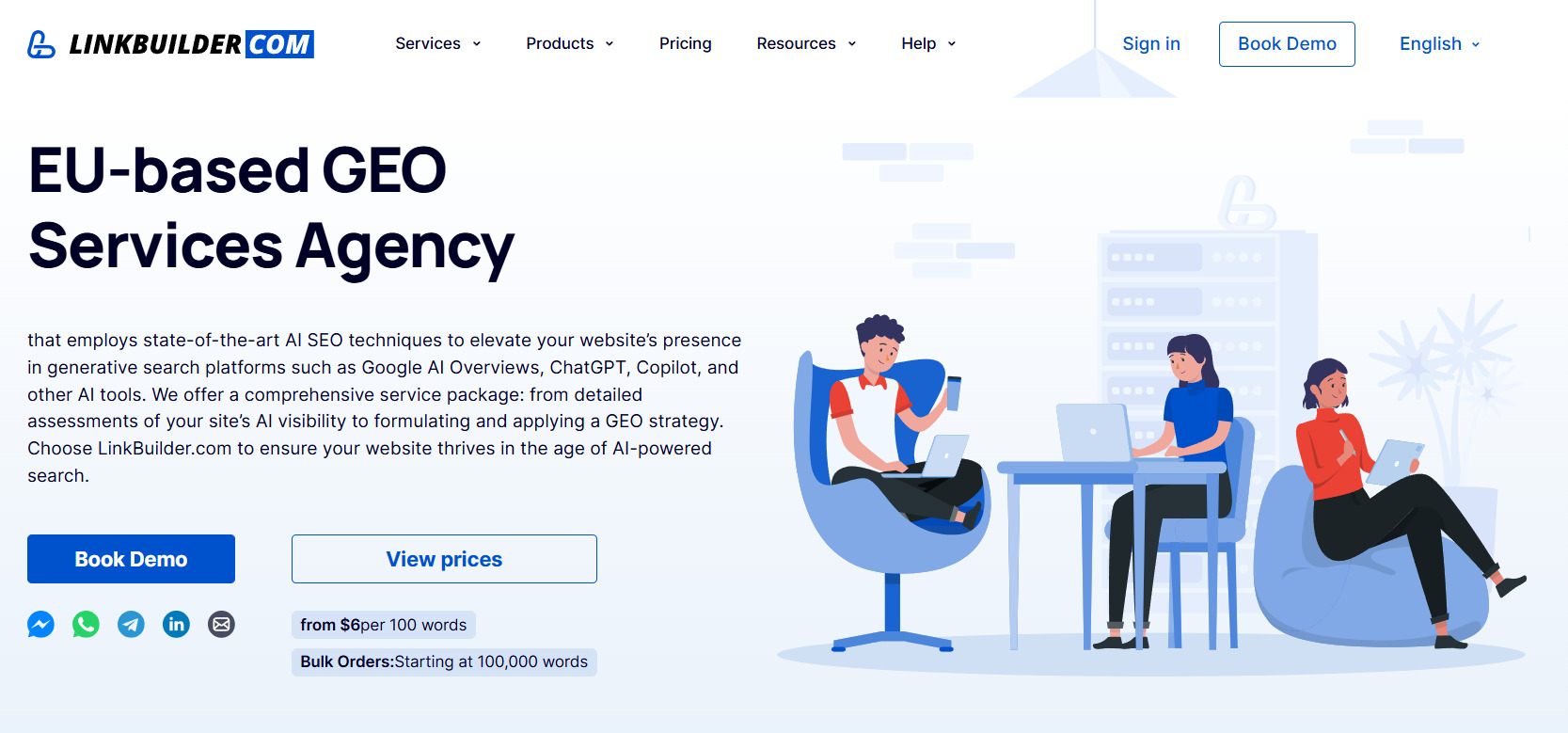
LinkBuilder’s team conducts in-depth audits of your site’s AI search presence, developing and implementing strategies with structured, AI-optimized content. Using NLP optimization, they monitor real-time brand mentions and adapt strategies to user behavior, ensuring businesses stay ahead in the AI search era.
Cross-Platform Search and Digital Asset Portability
Users want to transfer avatars, items, and achievements across platforms, creating new challenges for SEO for the Metaverse.
Cross-platform search demands standardized metadata, unified identity protocols, compatible action histories, and interoperable reputation systems. Optimization must account for this interconnectivity.
Ethical Challenges: Privacy, Digital Inequality, and Regulation
Data privacy is a critical concern in the metaverse, where systems collect vast behavioral data. Transparent data practices are essential.
Digital inequality risks excluding users without access to VR hardware or high-speed internet. Regulation is still emerging, lagging behind technological advancements, requiring brands to anticipate legal shifts.
Ethical metaverse principles:
- Transparent data collection and use.
- Equal access to opportunities.
- Protection against discrimination.
- Responsible data handling.
- Respect for digital rights.
These factors shape brand trust and reputation in virtual spaces.
Practical Steps to Start: Preparing Your Brand Today

To ready your brand for virtual spaces:
- Research Your Audience – Identify the platforms your customers use and analyze their virtual behavior.
- Launch a Pilot Project – Start with a virtual showroom, AR filter, or metaverse event to test audience response.
- Train Your Team – Learn 3D content creation and virtual environment tools to avoid pitfalls.
- Track Metrics – Measure results and refine your strategy.
- Partner with Agencies – Leverage services like those from LinkBuilder.com to optimize for the metaverse and AI search.
Flexibility is key in this fast-changing landscape.
Conclusion: Integrating Virtual and Real in Your Marketing Strategy
The metaverse is no longer a future concept – it’s a reality for digital marketing in the Metaverse. SEO for the Metaverse is in its early stages, offering a prime opportunity for early adopters. Successful brands are already blending virtual and physical presence to create seamless consumer experiences.
Key steps to take now:
- Start with AR – Bridge your digital presence to the metaverse via augmented reality.
- Explore Major Platforms – Register and experiment with Decentraland, The Sandbox, or Roblox.
- Secure Virtual Land – Invest in strategic locations, even without immediate activation.
- Adapt Content Strategy – Experiment with 3D models, VR tours, and immersive formats.
- Optimize for AI SEO – Order GEO services from LinkBuilder.com to ensure discoverability.
- Update Your Tech Stack – Implement virtual object metadata and blockchain integrations.
While technologies evolve, core marketing principles endure: deliver user value, create quality content, and foster authentic interactions.








